All published articles of this journal are available on ScienceDirect.
Assessment of Male Students’ Basic Badminton Technique Development at High Schools
Abstract
Aim:
Assessment of male students’ basic badminton technique development at high schools
Objective:
Physical education is an integral part of high school curriculums, contributing to students’ comprehensive development, and badminton is a sport of special interest at this level.
Methods:
However, due to different starting points, academic pressure and lack of frequent practice, students’ badminton training and performance are affected more or less. From this situation, we recognize the need to assess student’s basic techniques in high school badminton teams.
Results:
The study results demonstrate that 3 out of 7 tests to assess male students’ techniques in high school badminton teams show obvious progress and statistical significance.
Conclusion:
In particular, the moving and making straight drop shots has the highest growth rate with W = 13.5%, tcalculated=3.53.
1. INTRODUCTION
Physical fitness is the quality of the human body. It includes relatively stable characteristics in body morphology and functions, forming and developing based on the genetic basis and living conditions (through education and training). Therefore, physical education is a process that handles certain educational-training tasks. Their features are in the form of either pedagogical process or self-education [1-3]. Physical development is the process of transforming and shaping the natural properties of physical morphology and functions in natural and social life. In other words, physical development is the process of natural sequential transformation in morphology, physical functions and motor skills in every individual’s life [4]. At high schools, physical education is to protect and enhance students’ health, contributing to their comprehensive development and preparing them for creative activities and future careers. Standage et al. [5] studied self-determination in physical education at the high school level. The results support the theory of self-determination and verify the application of a common framework on physical education. Bechter et al. [6] identified potential motivations of high school students towards physical education and studied a model of hypothetical predictions. Hastie et al. [7] studied the development of badminton skills and tactical knowledge of 41 students through a training protocol. Using the performance data of students in the badminton skill test, they can determine whether the level of these students has improved.
Badminton is a widespread popular sport. Playing badminton supports players’ comprehensive development of the body, motor skills and respiratory organs. Moreover, it is suitable for people of all ages. Nowadays, the trends in badminton competition are proactive attack, speedy swoop and fast attack. Therefore, badminton is being promoted in physical education at the high school level [7-10].
This paper is to assess male students’ basic badminton technique development in high schools. Technique development after one year of training is assessed through the tests of participants’ reliability and notification.
2. METHODS
We use the academical method to check badminton players’ levels via assessment tests of basic techniques. After collecting coaches, experts and teachers’ opinions and getting 80% of their agreement, we examine the participants through the following tests: moving and making straight drop shots, making high clear shots along with the court, making high clear shots across the court, making straight drives, making cross-court drives, making short serves, and making long serves.
2.1. Moving and Making Straight Drop Shots
The aim of this test is to examine players’ drop technique and sense of using force. The way to perform is as in Fig. (1). The player stands at the midcourt while the server at the center position throws a low shuttle, near the net. The player quickly moves toward the net at the corner and makes a low drop shot near the net, onto the box (1m x 2.59m). Then the player comes back to the first position and makes the second shot, and so on until finishing 10 shots. Count the shots onto the box.
2.2. Making High Clear Shots Along with the Court
The aim of this test is to examine players’ drop technique and sense of using force. The way to perform is as in Fig. (2). The player stands at the midcourt while the server performs a forehand high serve. The player moves backward to make a clear straight shot and then quickly moves back to the first position for the second shot; and so on until finishing 10 shots. Count the shots onto the box (1m x 2.59m) and reach the required height.
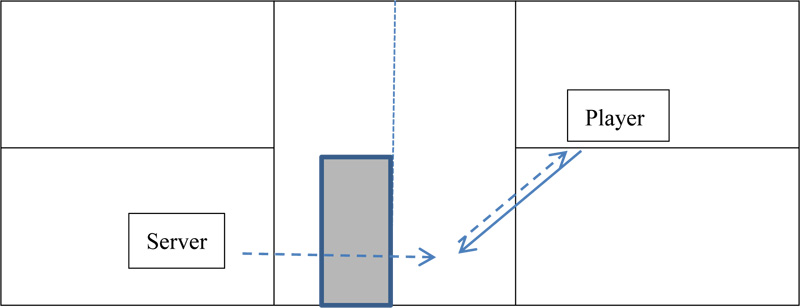
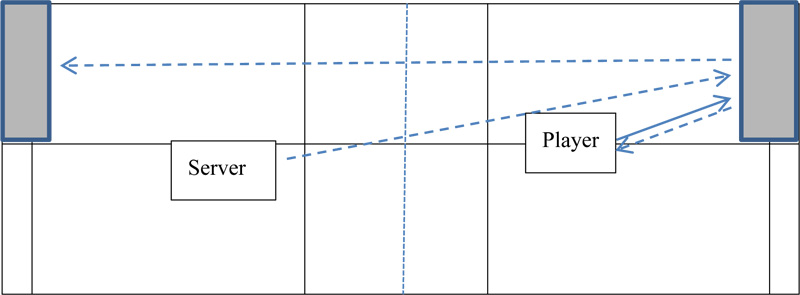
2.3. Making High Clear Shots Across the Court
This test is aimed at examining players’ technique, navigating ability and sense of using force. The way to perform is as in Fig. (3). The player stands at the midcourt while the server performs a forehand high serve. The player quickly moves in line with the shuttle, performs a high clear shot across the court onto the box (1m x 2.59m), and then quickly moves back to the first position for the second shot; and so on until finishing 10 shots. Count the shots onto the box and reach the required height.
2.4. Making Straight Drives
This test is aimed at examining players’ drive techniques and navigating ability. The way to perform is as in Fig. (4). The player stands at the midcourt while the server performs a forehand high serve. The player quickly moves toward the shuttle’s dropping point and makes a straight drive onto the box. Then the player moves back to the first position to perform the second shot; and so on until finishing 10 shots. Count the shots onto the box.
2.5. Making Cross-Court Drives
This test is aimed at examining players’ drive techniques and navigating ability. The way to perform is as in Fig. (5). The player stands at the midcourt while the server performs a forehand high serve. The player quickly moves toward the shuttle’s dropping point and makes a cross-court drive onto the box. Then the player moves back to the first position to perform the second shot, and so on until finishing 10 shots. Count the shots onto the box.
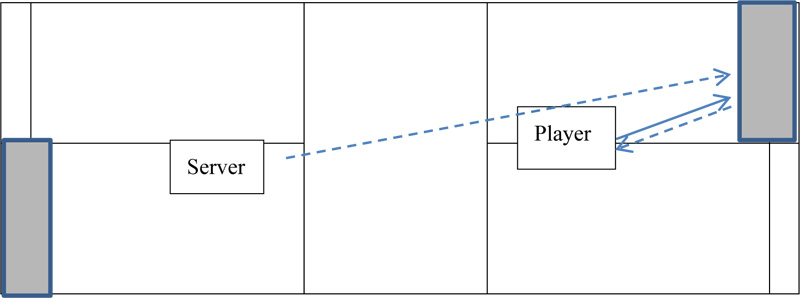
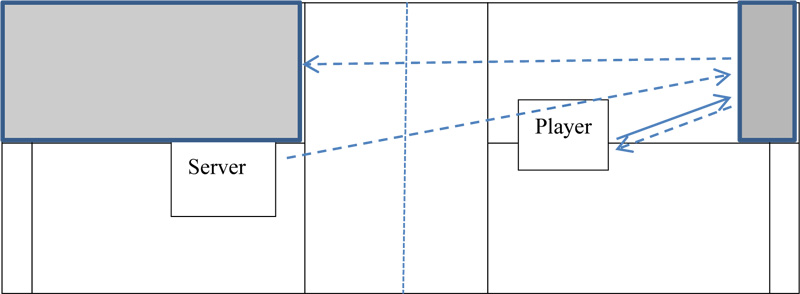
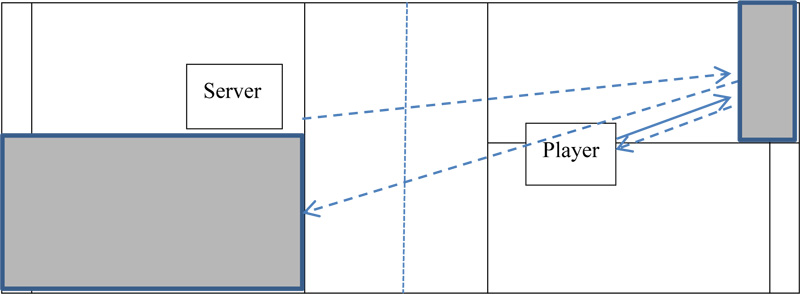
2.6. Making Short Serves
The aim of this test is to examine players’ serve techniques and the ability to use proper force. The way to perform is as in Fig. (6). The player stands at the position to make short serves, perform service technique across the court 10 times onto the box (1m). Count the shots onto the box and low near the net.
2.7. Making Long Serves
The aim of this test is to examine players’ serve techniques and the ability to use proper force. The way to perform is as in Fig. (7). The player stands at the midcourt to perform forehand high serve technique onto the box (1m). Count the shots onto the box and reach the required height.
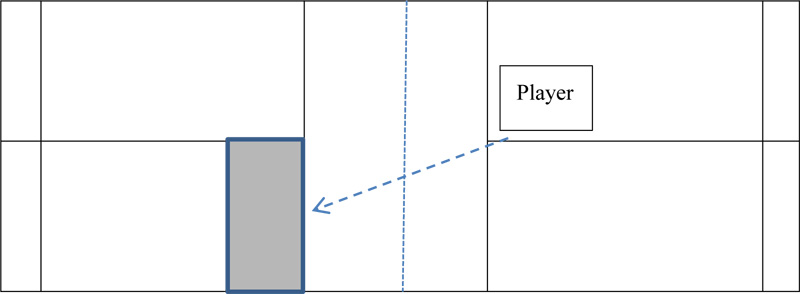
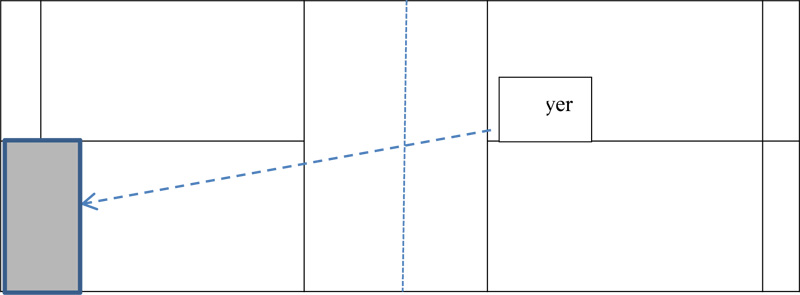
| No | Tests | Before Training | After Training | W(%) | t (calculated) | P | ||
|---|---|---|---|---|---|---|---|---|

|
S |

|
S | |||||
| 1 | Moving and making straight drop shots | 6.33 | 0.49 | 7.25 | 0.75 | 13.50 | 3.53 | < 0.05 |
| 2 | Making high clear shots along the court | 6.50 | 0.67 | 7.17 | 0.83 | 9.76 | 2.60 | < 0.05 |
| 3 | Making high clear shots across the court | 6.92 | 1.16 | 7.17 | 0.94 | 3.55 | 0.67 | < 0.05 |
| 4 | Making straight drives | 7.00 | 1.13 | 7.17 | 0.83 | 2.35 | 0.52 | < 0.05 |
| 5 | Making cross court drives | 7.00 | 1.13 | 7.67 | 0.89 | 9.09 | 1.34 | < 0.05 |
| 6 | Making short serves | 6.33 | 0.49 | 7.00 | 0.95 | 10.00 | 2.35 | < 0.05 |
| 7 | Making long serves | 6.58 | 0.67 | 7.25 | 1.06 | 9.64 | 1.54 | < 0.05 |
 is the average value, S is the standard deviation, W is the growth rate, t is the test value of two related samples, P is the correlation coefficient.
is the average value, S is the standard deviation, W is the growth rate, t is the test value of two related samples, P is the correlation coefficient.
3. RESULTS AND DISCUSSION
We carried out the research on 12 male students at Le Hong Phong High School for the Gifted, Ho Chi Minh City to assess the research method. We conduct the training for students for 1 year and are divided into 3 phases, with the number of exercises is 3 sessions/week, the total time of each exercise is 90 minutes. Phase 1 is adapted to normal speed. Phase 2 is to develop the maximum speed. Phase 3 is the basic technical development. To assess the development of basic techniques, data corresponding to each period were collected. We applied the S.Brody growth rate formula [11] to evaluate the results. The results are presented in Table 1.
After one year of training, 3 out of 7 tests to assess male students’ techniques in Le Hong Phong High School badminton teams, Ho Chi Minh City, show obvious progress and statistical significance at the possibility threshold (P < 0.05), as below:
The test of moving and making 10 straight drop shots onto the box (shots): After one year of training, we have the grow rate W = 13.30%; due to tcalculated = 3.53 > tstandard = 2.201, we can conclude that the growth is statistically significant at the possibility (P < 0.05).
The test of making 10 high clear shots along with the court onto the box (shots): After one year of training, we have the grow rate W = 9.67%; due to tcalculated = 2.60 > tstandard = 2.201, we can conclude that the growth is statistically significant at the possibility (P < 0.05).
The test of making 10 short serves onto the box (shots): After one year of training, we have the grow rate W = 10.00%; due to tcalculated = 3.35 > tstandard = 2.201, we can conclude that the growth is statistically significant at the possibility (P < 0.05).
After one year of training, the other 4 tests to assess male students’ techniques in Le Hong Phong High School badminton teams, Ho Chi Minh City, do not show remarkable progress and statistical significance at the possibility threshold (P < 0.05), as below:
The test of making 10 high clear shots across the court onto the box (shots): After one year of training, we have the grow rate W = 3.55%; due to tcalculated = 0.67 < tstandard = 2.201, we can conclude that the growth is not statistically significant at the possibility (P > 0.05).
The test of making 10 straight drives onto the box (shots): After one year of training, we have the grow rate W = 2.35%; due to tcalculated = 0.52 < tstandard e = 2.201, we can conclude that the growth is not statistically significant at the possibility (P > 0.05).
The test of making 10 crosses court onto the box (shots): After one year of training, we have the grow rate W = 9.09%; due to tcalculated = 1.43 < tstandard = 2.201, we can conclude that the growth is not statistically significant at the possibility (P > 0.05).
The test of making 10 long serves onto the box (shots): After one year of training, we have the grow rate W = 9.64%; due to tcalculated = 1.54 < tstandard = 2.201, we can conclude that the growth is not statistically significant at the possibility (P > 0.05).
The study results demonstrate that moving and making straight drop shots, making high clear shots along with the court, and making short serves tests to assess male students’ techniques in high school badminton teams show obvious progress and statistical significance. In particular, the moving and making straight drop shots have the highest growth rate, with W = 13.5%, tcalculated=3.53.
CONCLUSION
Through the study, it has been observed that after one year of training, 3 out of 7 tests to assess male students’ techniques in high school badminton teams show obvious progress and statistical significance. However, the rest, including making high clear shots across the court, making straight drives, making cross-court drives, and making long serves, do not show remarkable and statistical significance.
ETHICS APPROVAL AND CONSENT TO PARTICIPATE
The study was approved by the Ethics Committee of the Ho Chi Minh City University of Physical Education and Sport, Vietnam.
HUMAN AND ANIMAL RIGHTS
No Animals were used in this research. All human research procedures followed were in accordance with the ethical standards of the committee responsible for human experimentation (institutional and national), and with the Helsinki Declaration of 1975, as revised in 2013.
CONSENT FOR PUBLICATION
Not applicable.
AVAILABILITY OF DATA AND MATERIALS
The datasets analyzed during the current study available from the corresponding author [VHC] on reasonable request.
FUNDING
None.
CONFLICT OF INTEREST
The authors declare no conflict of interest, financial or otherwise.
ACKNOWLEDGEMENTS
Declared none.


